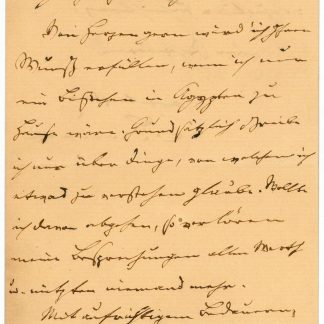Autograph letter signed.
4to. 1½ pp. on bifolium with address on verso.
€ 65,000.00
To the 1st Earl of Shelburne, regarding the health of his son Thomas, at the time Smith's student and lodger: "My Lord / It gives me as much pleasure to write to your Lordship today as it gave me pain to write to you by last post. The Doctors Predictions have upon this occasion been literally and exactly fulfilled. Mr. Fitzmaurice had the night before last a very slight attack of his fever which he was relieved from by a gentle sweat; and last night he had a bleeding at the nose which Dr. Black regards as a perfect crisis. He has since been entirely free from all feverish ailments or symptoms [...]". Written in ink in a neat cursive hand, approximately 23 lines to the page, with a few corrections in the text, addressed on the verso of the second sheet, annotated: "Mr. Smith concerning my son Thomas’s health". Sometime folded for posting, some light soiling along the folds.
Adam Smith was appointed professor of logic, and then of moral philosophy at Glasgow in 1751 and 1752 respectively. As a professor, Smith took students into his house, offering both supervision in studies and board and lodging. Of these students, the names of only two have come down to us: Henry Herbert, later Lord Porchester, and Thomas Petty-Fitzmaurice. In 1758 Gilbert Elliot, later Lord Minto, recommended Glasgow University rather than Oxford for the education of the younger son of the 1st Earl of Shelburne (the maternal grandson of the economist William Petty). Petty-Fitzmaurice (1742-93) had earlier been educated at Eton. For two years from 1759, Thomas Petty-Fitzmaurice lived with Adam Smith. After Glasgow he went to St Mary's Hall, Oxford, in 1761, was called to the English Bar in 1768 and became a Member of Parliament in 1762. In 1779 he set up as a linen merchant and established a bleaching factory at Llewenny in Wales, as his Irish estates were unproductive. He was reported to have lived on “the most intimate terms with Johnson, Hawkesworth and Garrick”. The total number of recorded letters written by Adam Smith is surprisingly small - about 200, of which at least 24 are only known from published sources, which leaves about 176 letters surviving, virtually all in public collections. There are only 11 surviving letters of Adam Smith's predating his correspondence with Lord Shelburne.
Provenance: Bowood, home of the Earls of Shelburne.
Mossner, Correspondence of Adam Smith, no. 46 (full transcription included; deletions by Smith are not recorded).






